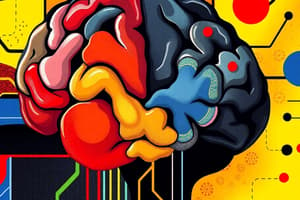Podcast
Questions and Answers
Which of the following is a representation of procedural knowledge using condition/action rules?
Which of the following is a representation of procedural knowledge using condition/action rules?
- Logical Reasoning
- Scripts
- Gestalt Theory
- Production Rules (correct)
What problem-solving strategy involves working towards a desired outcome?
What problem-solving strategy involves working towards a desired outcome?
- Slips and Mistakes
- Analogy
- Means-Ends Analysis (correct)
- Chunking
Which of the following is a process that involves drawing parallels between similar problems in different domains?
Which of the following is a process that involves drawing parallels between similar problems in different domains?
- Logical Reasoning
- Affect
- Analogy (correct)
- Individual Differences
What term refers to the organization of information into meaningful units to improve memory?
What term refers to the organization of information into meaningful units to improve memory?
Which of the following is a physiological and psychological response to stimuli that influences cognition?
Which of the following is a physiological and psychological response to stimuli that influences cognition?
What term refers to the variances in sex, physical and intellectual abilities, stress, fatigue, and age among users?
What term refers to the variances in sex, physical and intellectual abilities, stress, fatigue, and age among users?
What is the term used to describe the immediate, very brief recording of sensory information in the memory system?
What is the term used to describe the immediate, very brief recording of sensory information in the memory system?
Which of the following is responsible for color vision in the retina?
Which of the following is responsible for color vision in the retina?
What is the term used to describe the awareness of body position and movement?
What is the term used to describe the awareness of body position and movement?
Which of the following describes the ability to perceive detail in visual stimuli?
Which of the following describes the ability to perceive detail in visual stimuli?
What is the term used to describe the temporary storage system that actively holds multiple pieces of information?
What is the term used to describe the temporary storage system that actively holds multiple pieces of information?
Which of the following is a mathematical model describing the time required to move to a target area?
Which of the following is a mathematical model describing the time required to move to a target area?
Flashcards are hidden until you start studying
Study Notes
Cognitive Psychology
- Scripts are models of stereotypical information required to interpret a situation.
Artificial Intelligence
- Production Rules are a representation of procedural knowledge using condition/action rules.
Logical Reasoning
- It involves deduction, induction, and abduction processes.
Problem Solving
- It involves finding solutions to unfamiliar tasks using knowledge.
- Gestalt Theory: Problem solving involves both productive and reproductive processes.
- Means-Ends Analysis is a problem-solving strategy involving working towards a desired outcome.
- Analogy involves drawing parallels between similar problems in different domains.
Memory and Learning
- Chunking: Organizing information into meaningful units improves memory.
- Slips and Mistakes: Errors in actions or intentions can occur.
- Emotions: Physiological and psychological responses to stimuli influence cognition.
- Affect: Emotional response influences behavior and decision-making.
Human Factors
- Individual Differences: Variance in sex, physical and intellectual abilities, stress, fatigue, and age among users should be considered in interface design.
- Interface Design Implications: Considerations for stress, user experience, and individual differences are important in designing interfaces.
Information Input/Output
- Information i/o refers to the input and output of information, encompassing visual, auditory, haptic, and movement cues.
Human Perception
- Sensory Memory: Immediate, very brief recording of sensory information in the memory system.
- Short-Term Memory (STM) / Working Memory: Temporary storage system that actively holds multiple pieces of information.
- Long-Term Memory (LTM): The relatively permanent and limitless storehouse of the memory system.
Visual Perception
- Visual Angle: Indicates how much of a view an object occupies, related to size and distance from the eye.
- Visual Acuity: Ability to perceive detail in visual stimuli.
- Brightness: Subjective reaction to levels of light.
- Colour: Comprising hue, intensity, and saturation, perceived by cones sensitive to different wavelengths.
Anatomy of the Eye
- Retina: The light-sensitive layer of tissue at the back of the eye, containing photoreceptor cells (rods and cones) that convert light into neural signals.
- Rods: Photoreceptor cells in the retina responsible for low-light vision.
- Cones: Photoreceptor cells in the retina responsible for color vision.
- Ganglion Cells: Cells in the retina that receive visual information from photoreceptors and transmit it to the brain via the optic nerve.
Kinesthesis and Reaction Time
- Kinesthesis: Awareness of body position and movement.
- Reaction Time: Time taken to respond to a stimulus.
Motor Control
- Fitts Law: Mathematical model describing the time required to move to a target area.
Data Structures
- Frames: Information organized in data structures with slots for values.
Studying That Suits You
Use AI to generate personalized quizzes and flashcards to suit your learning preferences.




